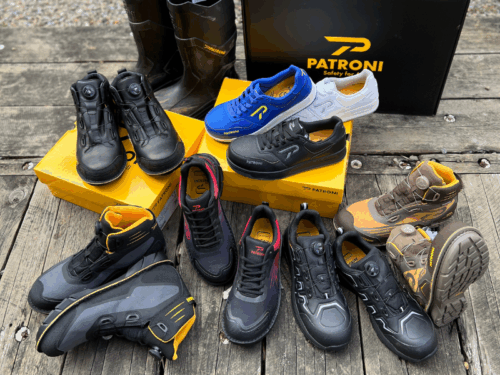From CNS 20345 to EN ISO 20345:2022 — A Complete Guide to the Differences Between Safety, Protective, and Occupational Footwear
When choosing safety shoes, you often see codes like “CNS 20345” or “EN ISO 20345.” These are not just labels — they represent different international and national standards for safety footwear testing and certification.
In this article, we start with Taiwan’s CNS standards, compare the differences among CNS 20345, CNS 20346, and CNS 20347, explain their relationship with Europe’s EN ISO 20345, and highlight the major updates introduced in the latest 2022 version.
CNS 20345 / CNS 20346 / CNS 20347 — What’s the Difference?
Taiwan’s national footwear safety standards are divided into three main categories:
-
CNS 20345: Safety Footwear
The highest level of protection, requiring 200J impact resistance and 15kN compression resistance at the toecap. It is suitable for high-risk working environments and includes additional requirements such as slip resistance, heat resistance, and antistatic protection. -
CNS 20346: Protective Footwear
A slightly lower protection level with 100J impact resistance and 10kN compression resistance, designed for moderate-risk workplaces. -
CNS 20347: Occupational Footwear
This category does not require toe protection and focuses instead on comfort, slip resistance, shock absorption, and abrasion resistance — ideal for low-impact occupational settings.
In short, CNS 20345 offers the highest protection, followed by CNS 20346, while CNS 20347 is designed for lighter, everyday use. The three standards share similar structures and testing logic but differ in protection level and intended environment.
Relationship Between CNS 20345 and EN ISO 20345
CNS 20345:2015 was revised based on ISO 20345:2011 (2nd Edition), with no technical changes, as officially stated by Taiwan’s Bureau of Standards, Metrology and Inspection (BSMI) under the Ministry of Economic Affairs.
This means CNS 20345 is a direct adoption of the ISO international standard, and its test methods and performance levels are the same as those used in EN ISO 20345:2011 within the European Union.
However, international standards continue to evolve. ISO 20345 released its 3rd edition in 2021, and the European version EN ISO 20345:2022 has become the latest CE compliance benchmark, gradually replacing the older 2011 version from 2023 onward.
Therefore, Taiwan’s current CNS 20345:2015 corresponds to ISO 20345:2011 (2nd Edition), while the European market now follows EN ISO 20345:2022 (3rd Edition) — meaning there is roughly one version gap between the two.
Updates in EN ISO 20345:2022 Compared to CNS 20345 (2011/2015)
The new EN ISO 20345:2022 introduces several important updates to better reflect real-world working conditions and advanced safety requirements:
-
Upgraded Puncture Resistance: PL / PS Classification
-
PL: Tested with a 4.5 mm nail
-
PS: Tested with a 3.0 mm thin nail (provides stronger protection under higher pressure)
Traditional steel plates continue to be marked as “P.”
-
-
Slip Resistance Updated to “SR”
The older SRA / SRB / SRC ratings are replaced by the simplified “SR” symbol for enhanced slip resistance. -
New LG (Ladder Grip) Requirement
The arch area must have a horizontal tread depth of at least 1.5 mm to ensure stability when standing on ladder rungs. -
New SC (Scuff Cap) Test for Toe Abrasion
Specifies the durability requirements for reinforced toe scuff areas (commonly referenced to 8,000 Martindale abrasion cycles). -
Clearer WR / WPA Waterproof Testing
Redefines water penetration and absorption tests for both the upper and the entire shoe to improve labeling accuracy. -
FO (Fuel Oil Resistance) Becomes an Optional Feature
Previously mandatory in certain categories, FO is now marked as an optional additional requirement.
Overall, the 2022 revision aligns more closely with real-world workplace risks, adding precision and functional upgrades to improve protection.
Applying Taiwan and European Standards
Taiwan currently follows CNS 20345:2015 as its official national safety footwear standard, so older symbols like SRA / SRC and P are still in use.
For companies exporting to the EU or aiming to meet global standards — especially in high-risk applications involving heights, sharp objects, or heavy wear — it’s recommended to choose footwear that also meets EN ISO 20345:2022 for the latest protective features (LG, SC, PS, SR, etc.).
For local procurement or government tenders in Taiwan, CNS certification remains the primary requirement, but CE 2022 compliance is increasingly recognized as a mark of technical excellence and international competitiveness.
PATRONI Compliance and Product Achievements
All PATRONI footwear models have passed the CNS 20345 national safety standard, ensuring full compliance with Taiwan’s highest protection requirements.
In addition, selected models — including SF2307 (Warlord Boot) and SF2319 (Ladder Walker) — have also obtained EN ISO 20345:2022 certification.
These certified models demonstrate PATRONI’s alignment with the latest European safety standards, offering advanced protection such as Ladder Grip (LG), Scuff Cap (SC), fine-nail puncture resistance (PS), and enhanced slip resistance (SR) — providing professionals with complete, reliable foot protection for modern workplaces.

Understanding footwear safety standards helps you make better, safer choices.
CNS 20345 sets the foundation, while EN ISO 20345:2022 represents the evolution of safety performance.
At PATRONI, our brand philosophy is to go beyond the standard — ensuring that every pair not only meets certification requirements but also enhances comfort, durability, and confidence for every professional.

